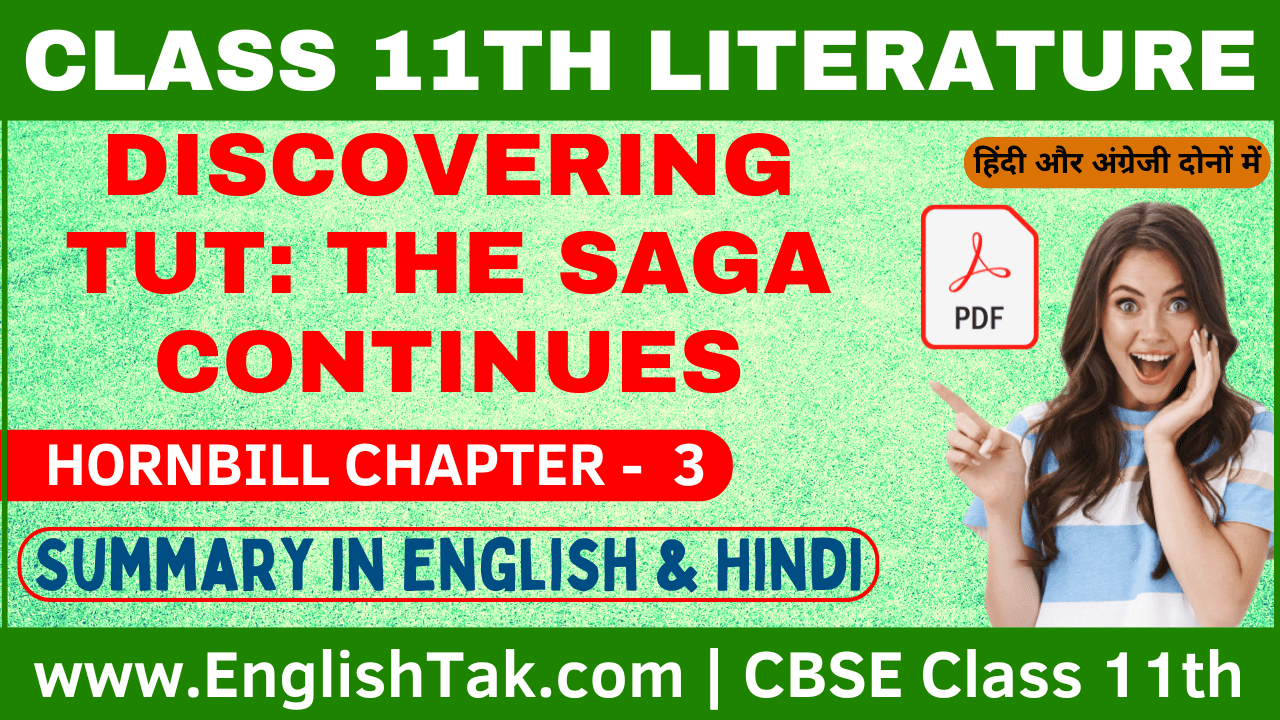![]()
Discovering Tut: the Saga Continues Summary Class 11 English
Table of Contents
Discovering Tut: the Saga Continues Summary Class 11 English – Summary of “Discovering Tut: The Saga Continues” by A.R. Williams, focusing on key events, themes, and insights Summary Class 11 English.
Discovering Tut: the Saga Continues Summary
Chapter 1: The Boy King
Historical Context: The chapter introduces the political and social landscape of ancient Egypt during the 18th Dynasty. It discusses the transitional period following the reign of Akhenaten, Tutankhamun’s father, whose radical religious reforms led to significant unrest.
Tutankhamun’s Birth and Early Life: Williams describes Tutankhamun’s birth around 1341 BCE, emphasizing his royal lineage. The author outlines the roles of his parents, Akhenaten and Nefertiti, and their influence on his upbringing.
Rise to Power: The narrative details Tutankhamun’s ascension to the throne at the tender age of around 8 or 9, focusing on the political machinations and power struggles surrounding his coronation.
Advisors and Influence: The chapter highlights key figures in Tutankhamun’s court, particularly Ay, who would later become pharaoh. The importance of advisors in shaping Tutankhamun’s decisions is discussed, suggesting that he was more a figurehead than a ruler.
इस अध्याय में प्राचीन मिस्र के अठारहवें वंश के दौरान की राजनीतिक और सामाजिक परिस्थितियों का परिचय दिया गया है। यह अक्हेनातेन, जो तूतनखामन के पिता थे, के शासन के बाद के संक्रमण काल पर चर्चा करता है। अक्हेनातेन के धार्मिक सुधारों ने मिस्र में बड़े पैमाने पर अस्थिरता और अशांति पैदा की थी।
विलियम्स तूतनखामन के जन्म को लगभग 1341 ईसा पूर्व के आसपास बताते हैं, और उनके शाही वंश को खासतौर पर रेखांकित करते हैं। लेखक तूतनखामन के माता-पिता, अक्हेनातेन और नेफ़रतिती, की भूमिकाओं और उनके पालन-पोषण पर उनके प्रभाव को भी विस्तार से समझाते हैं।
कहानी में तूतनखामन के लगभग 8 या 9 वर्ष की उम्र में राजा बनने का वर्णन किया गया है, और इस पर ध्यान केंद्रित किया गया है कि उनके राज्याभिषेक के समय किस तरह की राजनीतिक चालें और सत्ता संघर्ष चल रहे थे।
इस अध्याय में तूतनखामन के दरबार की महत्वपूर्ण हस्तियों का जिक्र किया गया है, विशेष रूप से आय (Ay), जो बाद में स्वयं राजा बने। सलाहकारों की तूतनखामन के निर्णयों में भूमिका पर चर्चा की गई है, जिससे यह संकेत मिलता है कि वह वास्तविक शासक कम और एक प्रतीकात्मक राजा अधिक थे।
Chapter 2: The Tomb’s Discovery
Howard Carter’s Journey: This chapter recounts Howard Carter’s meticulous search for Tutankhamun’s tomb in the Valley of the Kings, showcasing the challenges and setbacks he faced.
The Discovery of the Tomb: Williams describes the momentous day in November 1922 when Carter uncovered the entrance to the tomb, detailing the excitement and anticipation among archaeologists and the media.
Initial Findings: The chapter focuses on the first artifacts discovered, including the antechamber filled with items meant for the afterlife. Williams illustrates the breathtaking nature of these findings, such as the golden throne and intricately designed furniture.
Media Sensation: The sensationalism surrounding the discovery and the subsequent media frenzy is discussed, highlighting how it catapulted Tutankhamun into global fame.
यह अध्याय हावर्ड कार्टर की तूतनखामन की कब्र की खोज के लिए की गई मेहनती और विस्तृत खोज का वर्णन करता है, जो ‘वैली ऑफ़ द किंग्स’ में स्थित है। इसमें बताया गया है कि कार्टर को इस खोज के दौरान किन चुनौतियों और बाधाओं का सामना करना पड़ा।
विलियम्स नवंबर 1922 के उस ऐतिहासिक दिन का वर्णन करते हैं, जब कार्टर ने तूतनखामन की कब्र के प्रवेश द्वार को खोज निकाला। उस समय पुरातत्वविदों और मीडिया के बीच उत्साह और उम्मीद का माहौल बना हुआ था, जिसे लेखक विस्तार से बताते हैं।
अध्याय का मुख्य ध्यान उन पहले खोजे गए अवशेषों पर है, जिसमें मुख्य कक्ष (antechamber) में पाए गए जीवन के बाद की यात्रा से संबंधित वस्तुएं शामिल थीं। विलियम्स इन अवशेषों की अद्भुतता को चित्रित करते हैं, जैसे कि सोने का सिंहासन और बारीकी से डिजाइन किए गए फर्नीचर।
इस खोज के बाद की मीडिया की सनसनीखेज रिपोर्टिंग पर भी चर्चा की गई है, जिसमें बताया गया है कि किस तरह से इस खोज ने तूतनखामन को विश्वव्यापी प्रसिद्धि दिलाई।
Chapter 3: The Treasures Within
Comprehensive Artifact Analysis: Williams provides an in-depth look at the treasures found within the tomb, emphasizing their artistic and historical significance. He discusses items such as jewelry, weapons, and ceremonial objects.
Symbolism and Function: Each artifact’s purpose is examined, explaining its significance in the context of ancient Egyptian beliefs about the afterlife and the journey to the next world.
The Golden Mask: Special attention is given to Tutankhamun’s iconic golden mask, which is described as a masterwork of art, symbolizing his divine status and the importance of the pharaoh in Egyptian society.
Cultural Insights: The chapter highlights what these treasures reveal about daily life, religious practices, and social structures in ancient Egypt, portraying a civilization rich in tradition and artistry.
विलियम्स तूतनखामन की कब्र में पाए गए खजाने पर गहराई से नजर डालते हैं, और उनके कलात्मक तथा ऐतिहासिक महत्व को रेखांकित करते हैं। वह उन वस्तुओं पर चर्चा करते हैं, जैसे कि आभूषण, हथियार और धार्मिक वस्तुएं।
प्रत्येक अवशेष के उद्देश्य का विश्लेषण किया गया है, जिसमें यह समझाया गया है कि ये वस्तुएं प्राचीन मिस्री विश्वासों के संदर्भ में जीवन के बाद और अगले संसार की यात्रा के संबंध में क्या महत्व रखती हैं।
विशेष ध्यान तूतनखामन की प्रसिद्ध सोने की मास्क पर दिया गया है, जिसे कला का उत्कृष्ट नमूना बताया गया है। यह मास्क तूतनखामन की दिव्य स्थिति और मिस्र में फिरौन की महत्वता का प्रतीक है।
इस अध्याय में यह भी दर्शाया गया है कि ये खजाने प्राचीन मिस्र की दैनिक जीवन, धार्मिक प्रथाओं, और सामाजिक संरचनाओं के बारे में क्या बताते हैं, और यह एक ऐसी सभ्यता को दर्शाते हैं जो परंपरा और कला में समृद्ध थी।
Discovering Tut: the Saga Continues Summary Class 11 English
Chapter 4: Mysteries of His Death
Exploring Theories: This chapter delves into the various theories surrounding Tutankhamun’s premature death, presenting arguments for multiple potential causes, including accidents, illness, and foul play.
Medical Investigations: Williams discusses findings from CT scans and DNA analyses conducted on Tutankhamun’s mummy, revealing evidence of malaria, physical injuries, and possible genetic disorders, which contributed to the debate over the cause of death.
Political Context: The chapter posits that Tutankhamun’s death had significant political implications, potentially leading to instability in Egypt and the eventual rise of power struggles among the elite.
Legacy of His Death: The mysterious circumstances surrounding his demise contribute to the enduring intrigue of Tutankhamun, reinforcing the pharaoh’s status as a historical icon.
यह अध्याय तूतनखामन की समय से पहले हुई मृत्यु के चारों ओर के विभिन्न सिद्धांतों में गहराई से जाता है। इसमें कई संभावित कारणों, जैसे कि दुर्घटनाएं, बीमारियाँ, और हत्या, के लिए तर्क प्रस्तुत किए गए हैं।
विलियम्स तूतनखामन की ममी पर किए गए सीटी स्कैन और डीएनए विश्लेषणों के परिणामों पर चर्चा करते हैं। इन निष्कर्षों में मलेरिया, शारीरिक चोटों, और संभावित आनुवंशिक विकारों के सबूत मिलते हैं, जो मृत्यु के कारणों पर बहस को बढ़ाते हैं।
अध्याय में यह सुझाव दिया गया है कि तूतनखामन की मृत्यु का राजनीतिक निहितार्थ भी था, जो मिस्र में अस्थिरता का कारण बन सकता था और अंततः अभिजात वर्ग के बीच सत्ता संघर्षों को जन्म दे सकता था।
उनकी मृत्यु के चारों ओर के रहस्यमय हालात तूतनखामन की निरंतर जिज्ञासा को बढ़ाते हैं, और इस प्रकार फिरौन के ऐतिहासिक प्रतीक के रूप में उनकी स्थिति को मजबूत करते हैं।
Chapter 5: The Curse of the Pharaohs
Introduction to the Curse Myth: This chapter explores the infamous “Curse of the Pharaohs,” which purportedly afflicted those who entered Tutankhamun’s tomb. Williams analyzes how the concept emerged in popular culture.
Media Coverage: Williams discusses how sensational stories, often exaggerated or fabricated by the media, fueled public fascination and fear regarding the curse, leading to numerous reports of misfortune among those connected to the tomb’s discovery.
Scientific Examination: The author provides a scientific perspective, suggesting that factors such as bacteria or toxins present in the tomb’s environment may have contributed to illnesses among the expedition members, rather than a supernatural curse.
Cultural Impact: The chapter reflects on how the curse narrative has influenced literature, films, and other media, reinforcing the mystique surrounding Tutankhamun.
यह अध्याय प्रसिद्ध “फिरौन का श्राप” का अन्वेषण करता है, जो कथित तौर पर उन लोगों को प्रभावित करता था जो तूतनखामन की कब्र में प्रवेश करते थे। विलियम्स यह विश्लेषण करते हैं कि यह अवधारणा लोकप्रिय संस्कृति में कैसे उभरी।
विलियम्स चर्चा करते हैं कि कैसे मीडिया द्वारा अक्सर अतिशयोक्तिपूर्ण या निर्मित कहानियों ने श्राप के प्रति जनता की जिज्ञासा और भय को बढ़ावा दिया, जिसके परिणामस्वरूप कब्र की खोज से जुड़े लोगों के बीच कई दुर्भाग्य की रिपोर्ट आईं।
लेखक एक वैज्ञानिक दृष्टिकोण प्रदान करते हैं, जिसमें यह सुझाव दिया गया है कि कब्र के वातावरण में मौजूद बैक्टीरिया या विषाक्त पदार्थों ने खोज दल के सदस्यों में बीमारियों में योगदान दिया, न कि किसी अदृश्य श्राप के कारण।
इस अध्याय में यह भी दर्शाया गया है कि श्राप की कथा ने साहित्य, फिल्मों, और अन्य मीडिया पर कैसे प्रभाव डाला है, जिससे तूतनखामन के चारों ओर का रहस्य और भी गहरा हुआ है।
Chapter 6: Cultural Legacy : Discovering Tut: the Saga Continues Summary Class 11 English
Tutankhamun as a Cultural Icon: This chapter delves into the impact of Tutankhamun on modern culture, showcasing how the pharaoh has become a symbol of ancient Egypt.
Exhibitions and Global Tours: Williams discusses the significance of traveling exhibitions, such as “Tutankhamun: The Golden King and the Great Pharaohs,” in promoting public interest in ancient history and archaeology.
Artistic Influences: The author explores how Tutankhamun’s story has inspired artists, filmmakers, and designers, leading to a resurgence of Egyptian motifs in contemporary culture.
Educational Importance: Williams emphasizes the role of Tutankhamun in education, as his story serves as a gateway for students and the public to learn about ancient civilizations, art, and archaeology.
यह अध्याय तूतनखामन के आधुनिक संस्कृति पर प्रभाव की गहराई से पड़ताल करता है, यह दिखाते हुए कि कैसे यह फिरौन प्राचीन मिस्र का प्रतीक बन गया है।
विलियम्स यात्रा करने वाली प्रदर्शनों, जैसे कि “तूतनखामन: द गोल्डन किंग एंड द ग्रेट फिरौन,” के महत्व पर चर्चा करते हैं, जो प्राचीन इतिहास और पुरातत्व में सार्वजनिक रुचि को बढ़ावा देते हैं।
लेखक यह भी बताते हैं कि तूतनखामन की कहानी ने कलाकारों, फिल्म निर्माताओं, और डिजाइनरों को कैसे प्रेरित किया है, जिससे समकालीन संस्कृति में मिस्री तत्वों की पुनर्स्थापना हुई है।
विलियम्स तूतनखामन की शिक्षा में भूमिका को भी महत्वपूर्ण मानते हैं, क्योंकि उनकी कहानी छात्रों और जनता के लिए प्राचीन सभ्यताओं, कला, और पुरातत्व के बारे में जानने का एक प्रवेश द्वार प्रदान करती है।
Chapter 7: The Ongoing Search
Modern Archaeology and Techniques: This chapter highlights the advancements in archaeological methodologies and technologies that have emerged since Carter’s time. Techniques such as ground-penetrating radar and digital mapping are discussed.
Recent Discoveries: Williams presents recent findings in the Valley of the Kings, including the discovery of previously unknown tombs and artifacts, showcasing the ongoing fascination with Tutankhamun and his era.
Ethical Considerations: The chapter addresses the ethical implications of excavation and preservation in modern archaeology, stressing the importance of respecting cultural heritage while pursuing scientific inquiry.
Future Prospects: Williams concludes with a discussion on the future of archaeological exploration in Egypt and the potential for new discoveries to reshape the understanding of Tutankhamun’s life and ancient Egyptian society.
यह अध्याय उन पुरातात्विक विधियों और तकनीकों में हुए विकास को उजागर करता है जो कार्टर के समय के बाद उभरी हैं। इसमें ग्राउंड-पेनिट्रेटिंग रडार और डिजिटल मानचित्रण जैसी तकनीकों पर चर्चा की गई है।
विलियम्स किंग्स की घाटी में हाल के निष्कर्षों को प्रस्तुत करते हैं, जिसमें पहले अज्ञात कब्रों और अवशेषों की खोज शामिल है, जो तूतनखामन और उसके युग के प्रति निरंतर रुचि को दर्शाते हैं।
अध्याय में आधुनिक पुरातत्व में खुदाई और संरक्षण के नैतिक पहलुओं पर भी चर्चा की गई है, जिसमें सांस्कृतिक धरोहर का सम्मान करते हुए वैज्ञानिक जांच को आगे बढ़ाने के महत्व पर जोर दिया गया है।
विलियम्स इस चर्चा के साथ समाप्त करते हैं कि मिस्र में पुरातात्विक खोजों का भविष्य कैसा होगा और नए निष्कर्ष तूतनखामन के जीवन और प्राचीन मिस्री समाज की समझ को कैसे पुनः आकार दे सकते हैं।
Conclusion : Discovering Tut: the Saga Continues Summary Class 11 English
A.R. Williams’ “Discovering Tut: The Saga Continues” offers a comprehensive and insightful exploration of Tutankhamun’s life, the discoveries surrounding his tomb, and the ongoing significance of his legacy. Through detailed examination and engaging narrative, Williams captures the essence of one of history’s most enigmatic figures, ensuring that Tutankhamun remains a vital part of both ancient history and modern culture.
Discovering Tut: the Saga Continues Summary in Hindi
तूतनखामन: द सागा कंटिन्यूज़ का निष्कर्ष
तूतनखामन महान फिरौन वंश के अंतिम नेता थे। उनकी मृत्यु के समय वे युवा थे। कुछ लोगों का मानना है कि उनकी मृत्यु हत्या थी। वर्ष 1922 में, एक पुरातत्वज्ञ, हावर्ड कार्टर, ने उनकी कब्र का खुलासा किया। 80 वर्षों बाद, उनकी ममी का सीटी स्कैन किया गया ताकि उनके जीवन और मृत्यु के रहस्य को फोरेंसिक पुनर्निर्माण के माध्यम से हल किया जा सके।
उनके पिता या दादा, अमेनहोटेप III, एक बहुत शक्तिशाली फिरौन थे, जिन्होंने 40 वर्षों तक शासन किया। इसके अलावा, उनके बेटे, अमेनहोटेप IV, ने उन्हें सफल किया और मिस्र के इतिहास में सबसे अजीब काल की शुरुआत की। उनका नाम बदलकर अक्हेनातेन रखा गया, जिसका अर्थ है एथेन्स का सेवक। उन्होंने धार्मिक राजधानी को थेब्स से अमर्ना स्थानांतरित किया। बाद में, उन्होंने एक देवता, अमुन, पर हमला किया, उसकी मूर्तियों को नष्ट किया और उसके मंदिरों को बंद कर दिया। उनके बाद एक और रहस्यमय शासक आया, जो बहुत जल्दी ही मृत्यु को प्राप्त हुआ। तूतनखामन ने सत्ता संभाली और 9 वर्षों तक शासन किया।
जब तूत की ममी मिली, तो उसके पास बहुत सारे सोने और धन थे। कार्टर ने उन्हें इतने वर्षों बाद पाया। खजाने पर शोध करने के बाद, उन्होंने उनकी 3 घोंसलेदार बक्सों की जांच करने की योजना बनाई। कब्र में कई खजाने पहले ही गुम हो चुके थे।
उनकी कब्र चट्टान में खोदी गई थी, जो जमीन से 26 फीट नीचे थी, और उसमें कुछ दीवार चित्र भी थे। इससे यह स्पष्ट होता है कि वे मार्च या अप्रैल के महीनों में दबाए गए थे। एक कोफिन ने कार्टर को परेशानी में डाल दिया। तूत को ठोस सोने के नीचे चिपकाने के लिए जो गोंद का उपयोग किया गया था, वह बहुत मजबूत था। कोफिन इतना कठोर था कि उसे हिलाना असंभव था। उन्होंने कई घंटों तक इसे धूप में रखा ताकि रेजिन ढीली हो जाए, लेकिन यह काम नहीं किया।
अंत में, उन्होंने चाकू और हथौड़े से चिपकने वाला पदार्थ हटा दिया। कार्टर ने महसूस किया कि उनके पास ममी को टुकड़ों में काटने के अलावा कोई और विकल्प नहीं था; नहीं तो चोर सोने और खजाने को लूट लेते। उनके लोगों ने पहले ममी का सिर हटाया, फिर उन्होंने प्रत्येक जोड़ को काट दिया। सभी अंगों को हटाने की प्रक्रिया के बाद, उन्होंने इसे रेत की परत पर रखा। उन्होंने अंगों को एक लकड़ी के बक्से में रखा और इसे मूल स्थान पर रख दिया।
बाद में, जनवरी 2009 में, ममी को सीटी स्कैन के लिए ले जाया गया, जिसमें सैकड़ों एक्स-रे लिए गए और 3D छवि बनाई गई। उस रात स्कैन के बाद, श्रमिकों ने उसकी ममी को कब्र से एक बक्से में रखा। वे रैंप और सीढ़ियों के माध्यम से गए और ममी को उस हाइड्रोलिक ट्रेलर पर उठाया, जिसमें स्कैनर था। अचानक स्कैनर काम करना बंद कर दिया और सीटी स्कैन की प्रक्रिया रुक गई। कुछ स्पेयर फैंस के उपयोग के बाद, स्कैन अंततः पूरा हुआ। 3 घंटे के बाद, उन्होंने उसकी ममी को वापस उसकी कब्र में स्थानांतरित किया, जहां उसकी ममी अब शांति से विश्राम कर रही है।
निष्कर्ष
अंत में, Discovering Tut: The Saga Continues का सारांश बताता है कि तूतनखामन, जिसे तूत के नाम से भी जाना जाता है, एक बहादुर शासक थे जो महान फिरौन वंश के थे। उनकी मृत्यु एक रहस्यमय तरीके से हुई और वह अब अपनी कब्र में शांति से विश्राम कर रहे हैं।
Class 11 English Solution
We Are Not Afraid to Die Difficult Words Hindi
CBSE Class 11 Hornbill Questions Answers Pdf
We’re Not Afraid to Die Summary
Discovering Tut the Saga Continues Word Meaning
The Portrait of a Lady Summary





